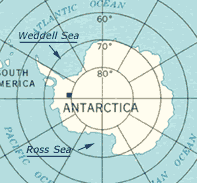|
|
|
|
Rivers in the Southern Ocean One of the main characteristics of the Southern Ocean resides in the fact that it is a major source of cold water production (by the formation of some 20 million square kilometres of ice The cold and dense water of the Antarctic - the "Antarctic Bottom Water" - is not the only water travelling in the oceans of the world. Above the deep layers that circulate at a depth of more than 4,000 metres, oceanographic soundings have found "deep circumpolar water" at a depth of less than 3,000 metres regulating the movements of the Southern Ocean. This a huge (very saline) water mass formed in the high latitudes of the Northern Hemisphere that wends its way towards the south. The surfacing of this warmer northern water (its temperature is on average 2 to 3°C higher than the cold water at the bottom) in the Antarctic polar regions is helped by the meeting of the westerly and easterly winds - the zone of Antarctic divergence - which often force the surface Antarctic water to divide in two, one part going northwards and the other towards the coasts. This perpetual toing and froing of water coming from different horizons and meeting in the Antarctic Ocean contributes, rather like the circulation of the atmospheric air mass, to the planet's climatic equilibrium. |

 floe per year) and therefore the great oxygenator of the other oceans. Experts have managed to locate the geographical sources that are producing this deep, cold and dense water: some 80% of it comes from the Weddell Sea and some 10% from the Ross Sea. As soon as it is formed, this dense and cold water plunges along the continental ramp then winds its way along the bottom of the abyssal plains. Then, once it has crossed what oceanographers call the "submarine threshold of the Rio Grande" a part of this cold water spills into the Brazil basin before continuing towards the mid-Atlantic ridge via the Romanche fault (between the Cape Verde Islands and Recife Point, Brazil) and going on to permeate the vast abyssal stretches beyond the Gulf of Gascoyne. The time taken by this water mass to complete its South/North, or Antarctic-Arctic journey, can amount to several million years. .
floe per year) and therefore the great oxygenator of the other oceans. Experts have managed to locate the geographical sources that are producing this deep, cold and dense water: some 80% of it comes from the Weddell Sea and some 10% from the Ross Sea. As soon as it is formed, this dense and cold water plunges along the continental ramp then winds its way along the bottom of the abyssal plains. Then, once it has crossed what oceanographers call the "submarine threshold of the Rio Grande" a part of this cold water spills into the Brazil basin before continuing towards the mid-Atlantic ridge via the Romanche fault (between the Cape Verde Islands and Recife Point, Brazil) and going on to permeate the vast abyssal stretches beyond the Gulf of Gascoyne. The time taken by this water mass to complete its South/North, or Antarctic-Arctic journey, can amount to several million years. .